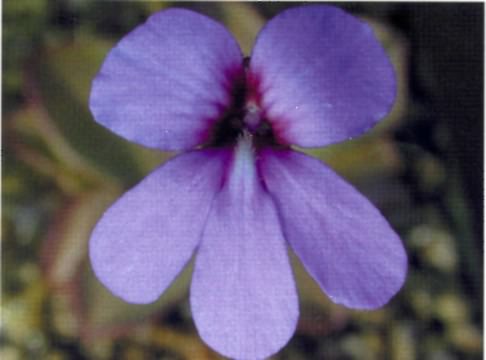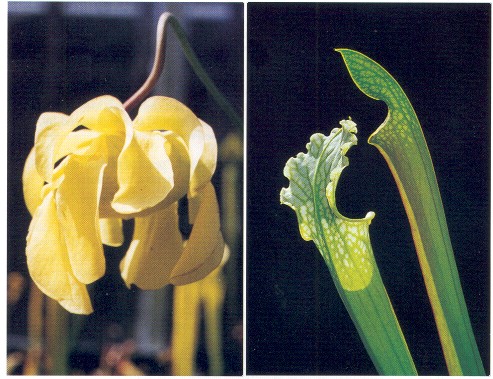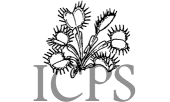|
Carnivorous Plant Newsletter
Volume 30, Number 1, March 2001, pages 11 - 14
NEW CULTIVARS
Pinguicula 'Titan'
Sarracenia leucophylla 'Schnell's Ghost'
Pinguicula 'Titan'
Received: 20 October 1999
This hybrid Pinguicula was created at by Leo C. Song,
Jr. on 17 July 1987. The seed parent was a fragrant clone of P.
agnata we grow at California State University at Fullerton.
This is the only fragrant Pinguicula we have, and its taxonomic
status is still uncertain. The pollen parent was an unidentified
Pinguicula collected by David Verity near Guanajuato, Mexico
in 1975. The pollen parent forms a hibernaculum below the surface
of the ground, sometimes at a depth of over 1.5 cm (1/2 inch), and
has flowers similar in form to P. gypsicola. It may be
P. macrophylla.
At its largest, the leaves of Pinguicula ‘Titan’
can exceed the confines of a 15 cm (six inch) pot! The leaves resemble
the pollen parent’s, in having a longer and more pronounced
petiole than the leaves of the seed parent. However, the flower
shape definitely favors the seed parent, but the blue edges have
been replaced with an even magenta glow. A slight fragrance is also
evident. It forms a large subterranean hibernaculum, but has a relatively
short dormant period.
Pinguicula ‘Titan’ is very vigorous and easy
to grow. We use a general mix for carnivorous plants (2 parts coco
peat, 2 parts peat moss, 1 part fine orchid bark, 3 parts #20 quartz
sand, 1-1.5 parts coarse perlite) to which we add a bit of dolomite
and gypsum (1 part to 800 parts potting mix). A 5 cm (2 inch) layer
of perlite is placed at the bottom of the pot for added drainage
and enhanced aeration. We grow it under lights and natural lighting.
It is being sold by a number of stores, such as Booman Floral of
Vista California. It survives on store shelves longer than all other
carnivorous plants, flowering there even after Venus Flytraps, sundews,
and Sarracenia have died.
The cultivar name ‘Titan’ was chosen both to indicate
the plants large size, but also to commemorate the nickname for
California State University, Fullerton. I nominated this name some
time in 1998, and it was sent (by Barry Rice) for registration on
20 October 1999. Pinguicula ‘Titan’ should
be propagated by vegetative means only in order to preserve its
distinctive characters.
LEO SONG, JR. • Fullerton, CA • USA

Figure 1: Pinguicula 'Titan' photographed by John Brittnacher.
Sarracenia leucophylla 'Schnell's Ghost'
Received: 4 February 2000
One of the peculiarities found in many of the red-flowered species
of Sarracenia are the so-called aberrant colour forms.
In addition to the range of pink and red colours found in many individuals
of these species, plants are occasionally discovered which have
pure yellow flowers. The genetics governing this effect are well
documented (Sheridan & Scholl, 1996; Sheridan, 1997) and are
known to affect red colour production in either the flower or the
entire plant.
Of particular merit is the yellow-flowered clone of Sarracenia
leucophylla. This plant has, in addition to the pure yellow
flower, a complete absence of red colouring in the upper-pitcher
tube and lid. The almost pure white lid is innervated with narrow
green veins; the white colour includes the inner lid-surface and
column, and extends to the upper section of the pitcher tube. The
only red colour in the plant is found in the growing points of emerging
pitchers and in aging pitchers as they start to senesce. Because
of this, the plant cannot be described as an anthocyanin-free plant
(or green mutant, as erroneously reported by D’Amato (1998,
page 82).
The yellow-flowered Sarracenia leucophylla was originally
collected by Donald Schnell during the summer of 1972. At the time
of this collection the plant was not in flower; presumably the intense
white colouration of the plant’s leaves attracted his attention.
Schnell sent a piece of the plant to Steven Clemesha in Australia,
who adjusted its growth habit to southern hemisphere seasons, and
grew the plant to maturity. It was not until the plant flowered
in September 1974 that Clemesha discovered that the plant also produced
a pure yellow flower (Clemesha, 1999, personal communication).
Some years later Martin Cheek obtained plants from Clemesha, propagated
them, and offered specimens for sale with the unregistered name
of “Schnell’s Ghost”. At the time Martin produced
a catalogue of plants which contained a full description of the
cultivar (Cheek, 1990, page 2).
Although references to this plant’s “very pale ghost-like
qualities” were made in private correspondence as early as
1972 (Clemesha, 1999, personal communication), the first printed
reference to its “ghost-like” qualities was in Schnell
(1989):
“The pitcher top is so pale and the lack of red venation
gives the plant an almost ghost-like appearance and it stands out
readily in a stand of typical plants, even when not in yellow flower.
This plant bore a yellow flower the following spring in cultivation….”
In the early 1990s Alan Hindle, a grower and collector of Sarracenia
forms in the UK, began selling a yellow-flowered S. leucophylla.
Alan Hindle received his original stock from Bruce Bednar in the
USA, so this plant subsequently became known among UK growers as
the “Bednar clone”. Bednar reported that he obtained
his plant from Clemesha in Australia, so the “Bednar clone”
is the same plant as the “Schnell’s Ghost” plant
(Bednar, 1999, personal communication). Other unestablished names
that have been used to label this S. leucophylla plant include “Alba”
and “Yellow Flower”.
Several other distinct clones of the species with yellow flowers
have subsequently been found. For instance, there is at least one
clone from the Citronelle region in southern Alabama. The plants
are again characterised by having predominantly white colouration
in the lid and upper pitcher, and a yellow flower. I am registering
the cultivar name Sarracenia leucophylla ‘Schnell’s
Ghost’, which should be applied to all clones of the species
with yellow flowers and predominantly white coloured lids and upper
pitchers. Since seed from self-pollinated individuals of this clone
breed true (and presumably between different clones of this cultivar),
Sarracenia leucophylla ‘Schnell’s Ghost’ may be
propagated both asexually from cuttings and sexually from seed,
as long as the cultivar characters are maintained.
As mentioned above, Sarracenia leucophylla ‘Schnell’s
Ghost’ does have some red pigmentation in the growing points.
In contrast, collections of Sarracenia leucophylla plants completely
lacking anthocyanin have been reported (Sheridan & Scholl, 1996).
The cultivar description of Sarracenia leucophylla ‘Schnell’s
Ghost’ does not include these plants. I am happy to report
that, despite fears that Sarracenia ‘Schnell’s
Ghost’ had become extinct (Rice, 2000), it is quite alive
both in England and in the USA.
References:
Cheek, M. 1990, Carnivorous Plant Trading Catalogue.
D'Amato, P. 1998, The Savage Garden, Berkeley, Ten Speed Press.
Meyers-Rice, B. 2000, Noted horticulturist Peter D'Amato murders Don Schnell, Carniv. Pl. Newslett., 29, 3.
Sheridan, P. 1997, Genetics of Sarracenia leaf and flower color, Carniv. Pl. Newslett., 26, 51-64.
Sheridan, P., and Scholl, B. 1996, Noteworthy Sarracenia collections II, Carniv. Pl. Newslett., 25, 19-23.
Schnell, D.E. 1989, Sarracenia alata and S. leucophylla variations, Carniv. Pl. Newslett., 18, 79-83.
PHIL WILSON • Martock, Somerset • England

Figure 2 (left): Sarracenia leucophylla 'Schnell's Ghost' photo by Phil Wilson.
Figure 3 (right): Sarracenia leucophylla 'Schnell's Ghost' photo by John Constable.
|

